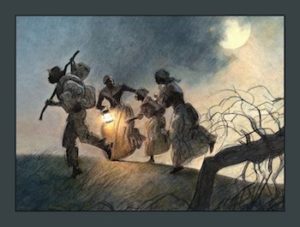
On this date, in 1787, the Underground Railroad is celebrated. This organization helped escaped African slaves from the Antebellum South on their journey to freedom in the North, Canada, and Mexico.
It is believed that it started and got its name when Isaac T. Hopper, a Quaker, organized a system for hiding and aiding escaped slaves. Opponents of slavery, abolitionists allowed their homes, called stations, to be used as places where escaped slaves were provided with food, shelter, and money. The routes crossed 14 northern states, Canada and Texas, heading to Mexico.
Mexico abolished slavery in 1829 when Texas was still part of the country, prompting white, slave-holding immigrants to fight for independence in the Texas Revolution. The Free Soil Party was a public policy influence too. The Alamo conflict was an indicator of America's Qwest spreading slavery in the Southwest. Once they formed the Republic of Texas in 1836, they made slavery legal again, and it continued to be legal when Texas joined the U.S. as a state in 1845.
Fugitive slaves got to Mexico in many different ways. Some went on foot, while others rode horses or were able to board ferries bound for Mexican ports. John Webber, a Unionist ally, settled in Texas and Mexico and aided slaves across the Rio Grande. In 1857, Nathaniel Jackson became one of the conductors using his ranch in south Texas. Stories spread about enslaved people who crossed the Rio Grande River dividing Texas from Mexico by floating on bales of cotton, and several Texas newspapers reported in July 1863 that three enslaved people had escaped this way.
It is estimated that by 1850, around 3,000 people worked on the Underground Railroad. Some of the best-known people who provided help on the route included William Still, Gerrit Smith, Salmon Chase, David Ruggle, Thomas Garrett, William Purvis, Jane Grey Swisshelm, William Wells Brown, Frederick Douglass, Henry David Thoreau, Lucretia Mott, Charles Langston, Levi Coffin, and Susan B. Anthony.
The Underground Railroad also used volunteers known as conductors who went to the South and helped guide slaves to safety. One of the most important was a former slave, Harriet Tubman. She made over 20 secret trips to the South, leading more than 1000 slaves to freedom. During the Civil War, with the Union army traveling to South Carolina, she was a liaison between the soldiers and newly freed Blacks, moving them towards self-sufficiency.
On the night of June 2, 1863, Tubman guided a troop of 150 Black soldiers of the Second South Carolina Battalion on the Combahee River. The plan was to liberate as many slaves as possible by catching slaveholders by surprise. The attack became known as the Combahee River Raid and liberated more than 750 slaves. Tubman was considered such a threat to the slave system that plantation owners offered a $40,000 reward for her capture.
Underground Railroad Stations were usually about 20 miles apart. Conductors used covered wagons or carts with false bottoms to carry slaves from one station to another. Runaway slaves usually hid during the day and traveled at night. Some involved notified runaways of their stations by brightly lit candles in a window or by lanterns in the front yard. By the middle of the 19th century, it was estimated that over 50,000 slaves had escaped from the South using the Underground Railroad.
British Educational Communications and Technology Agency, Millburn Hill Road,
Science Park, Coventry, CV4 7JJ,
Tel: 024 7641 6994,
Fax: 024 7641 1418